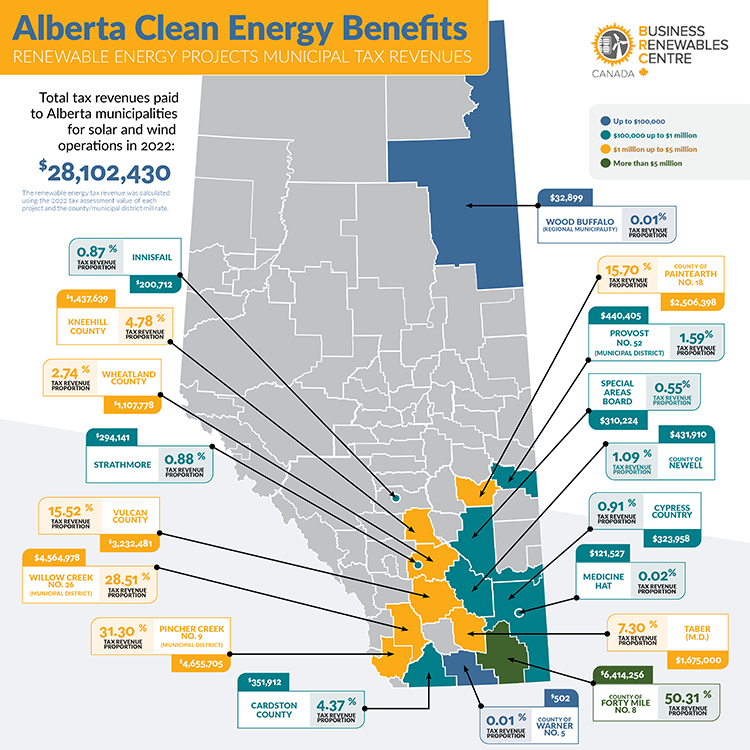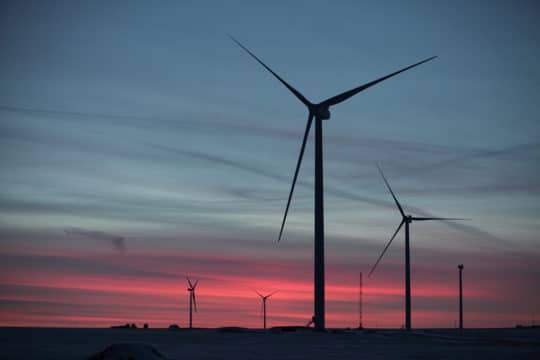Renewable energy projects, particularly wind and solar, have pumped millions into the tax revenues of many municipalities in Alberta.
The financial windfall from these projects has been substantial.
According to an analysis by the Business Renewables Centre-Canada (BRC-Canada), the municipal tax revenue from renewable energy in Alberta has almost tripled since 2017, reaching $28 million.
This growth is attributed to the increasing number of wind and solar projects.
The tax revenue was calculated based on the assessed value of each renewable project and the respective county or municipal district’s tax rate.
Impact on Municipal Budgets
The proportion of tax revenues from renewables varies across municipalities.
For example, the County of Forty Mile (50 percent), the M.D. of Pincher Creek (31 percent), the M.D. of Willow Creek (29 percent), the County of Paintearth (16 percent) and Vulcan County (15 percent) all receive substantial tax revenues.
Eight of the 18 districts with renewable energy projects receive over $1 million in tax revenues.
These funds have been instrumental in maintaining low land taxes in regions like Paintearth County despite a downturn in local oil and gas activity.
The revenue from renewables has also enabled municipalities to plan, and invest in community projects and stabilize their financial health.
This is in stark contrast with the $220 million in municipal taxes that oil and gas companies didn’t pay that the Alberta government documented in 2022.


Public Perception
A poll by the Pembina Institute revealed that three in four Albertans favour more renewable energy projects in their vicinity. Two of every three people living outside of Edmonton and Calgary support more renewable energy projects near their towns.
This sentiment aligns with the tangible benefits these projects bring, from financial gains to environmental advantages.
BRC-Canada‘s projections indicate a promising future for these municipalities.
Based on the 2022 calculations and the projects in the Alberta Electric System Operator connection queue, the revenue from renewables is expected to grow by an additional $170 million to $250 million in the coming years.
Concerns and Considerations
While the benefits are evident, there are concerns about the negative impact the Alberta government’s pause on renewable development approvals will have on municipal revenues.
This moratorium, set to expire on February 29, 2024, was implemented without consulting the renewables sector.
Various stakeholders, including municipalities, Indigenous communities, and industry groups, have criticized the decision.
The pause potentially delays new projects and the subsequent tax revenues they would bring.


A solar-advocating non-profit, Rise Up For Renewables (RUFR), is running a lawn sign campaign to demonstrate opposition to the province’s renewables moratorium and is starting to get sign orders from Albertans wanting to protest the renewables moratorium.
However, some municipalities, like the Municipal District of Pincher Creek and Vulcan County, have expressed concerns about the rapid expansion of wind projects without adequate input from residents. Other jurisdictions, like the Town of Innisfail, are left holding the bag on renewable projects in the cue.
Renewable energy projects have brought significant tax benefits to Alberta’s municipalities.
These funds have been crucial in bolstering local economies.
Alberta certainly has the potential to lead Canada – and, in some cases, the world – in wind, solar and geothermal innovation.
The questions are:
- Do we have the political leadership needed to renew the Alberta Advantage?
- Do we have the political leadership needed to set ambitious goals and incentivize technological breakthroughs to break new ground in the global energy transition?
The moratorium certainly didn’t set us on an ambitious path.






